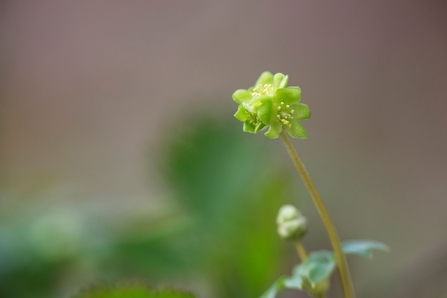A widespread and common plant with an amusing name is the Fat Hen (Chenopodium album). This plant grows in gardens, arable fields, roadsides, hedgerows and many other habitats. It is so common that it is often considered a weed. The Fat Hen flowers from June to October with spikes of whitish flowers rising from diamond shaped leaves. Before the introduction of spinach, it was often served boiled and buttered alongside meat. These days, it is considered a good food source for birds and insects. Fat Hen also goes by several other obscure names, including Bacon Weed, Dirty Dick, Goose Foot, Lamb's Quarters (USA) and Pig Weed.
Fat Hens, Creeping Jennys and Town Hall Clocks: strange plant names in nature
Moschatel Town Hall Clock © Mike Read
Creeping Jenny (Lysimachia nummularia) is a low growing perennial plant found it wetlands, riverbanks, ponds and wet woodland. Flowering from May to August and most prevalent in Southern England, the Creeping Jenny has a sunshine-yellow, cup-like flower crowning stalks that branch off a main stem. Its name derives from how the plant will ‘creep’ or spread through wet habitats with its spreading mats of long stems. A hardy plant with evergreen leaves and an attractive flower, it is a popular plant for gardeners to grow alongside a pond or water feature.
Creeping Jenny © Richard Burkmarr
One of the strangest plant names is the Moschatel Town Hall Clock (Adoxa moschatellina). Firstly, the ‘moschatel’ part comes from the flower’s musk-like scent. As for the ‘Town Hall Clock’ part, that is in reference to how the flowers face out in four different directions 90 degrees to each other sitting on top of an erect, slender stem. Each stem has five flowers with fifth facing upwards. This plant can be seen flowering between April and May and is widespread through most of the UK. It prefers shaded, moist habitats and is often found in deciduous woodland.

Moschatel Town Hall Clock © Mike Read
These three species aren’t alone in their unusual names. From the Pignut to the Shepherd’s Purse, there are many more to discover. To find out more on these species, or to discover some odd names for yourself, visit our species finder.
